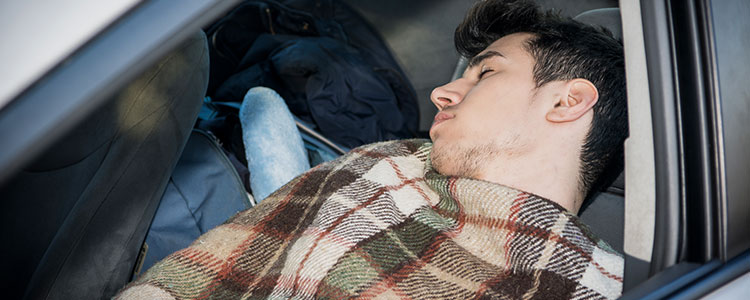Travelers can enjoy a wide range of activities in Indiana, sometimes known as the Hoosier State, from visiting the lively museums in Indianapolis to taking in the stunning scenery at locations like Brown County State Park. However, there are instances when unorthodox sleeping arrangements are required due to budgetary constraints, road trips, or unforeseen delays. This is the situation with vehicle sleeping. It could be a last resort for some, an affordable option for others, or an exciting experience for others.
A Complex Issue: Legality Varies by Location and Circumstances
But there is no simple answer to the question of whether it is allowed to sleep in a car in Indiana. In contrast to some states where laws are clear-cut, Indiana has a patchwork of legislation that vary according on the situation and place. This essay will discuss the legality of car sleeping on both public and private property, address issues with DUI laws, and offer substitute options for travelers looking for lodging. It will also traverse the complications of car sleeping in the Hoosier State.
Sleeping in Your Car on Public Property in Indiana
Although there is always room on public property for automobile sleeping, there are a lot of different legal constraints. Below is a summary of the important points to think about:
There isn’t a state statute in Indiana that addresses automobile sleeping expressly. This indicates that local municipalities have jurisdiction over the legality. Car sleeping may be indirectly impacted by municipal laws that regulate public camping, overnight parking, and loitering. It is also essential to familiarize yourself with the local legislation of the place you intend to reside. Clarity can be obtained by using resources like local law enforcement or municipal websites.
Overnight parking at rest sites is prohibited by the Indiana Department of Transportation (INDOT). Usually, there is signage alerting visitors to the rule. The probable cause of this is worries about extended stays at rest sites and safety issues.
While overnight parking is permitted at select Walmarts and casinos nationwide, Indiana does not always grant this option. To avoid any problems, it’s preferable to make your inquiry in advance with the manager of that particular store or the security staff.
In Indiana, a lot of public parks close after dusk. After closure time, sleeping in your car may be deemed trespassing or against park rules. Always confirm if sleeping in your car is allowed by reading the posted signage and park regulations.
Sleeping in Your Car on Private Property in Indiana
Permission is essential as private property provides a possibly more controlled setting for automobile sleeping.
In Indiana, it is normally OK to sleep in your automobile on private property as long as the proprietor gives you their express consent. This might be a friend, relative, or someone granting authorization for you to park overnight on their land (for example, some landowners let car camping on their property for a fee).
Unauthorized sleeping on private property is seen as trespassing. Landlords might request your removal by calling the police.
Indiana DUI Laws and Sleeping in Your Car
The possibility of being charged with DUI (driving under the influence) is a major worry for people who sleep in cars. In Indiana, driving while intoxicated is strictly prohibited, with a blood alcohol level (BAC) of 0.08% or above being deemed a DUI.
Refusing to be charged with DUI when sleeping in your car is all about proving you are not involved in any driving action. The following safety advice is provided:
Safety Tips: Separating Yourself from Driving Activity
Though the aforementioned recommendations can reduce the likelihood of a DUI prosecution, it’s crucial to remember that different legal interpretations and enforcement strategies may apply to these statutes. It is best to seek clarity from legal advice if you are worried about possible DUI accusations while sleeping in your automobile.
Alternatives to Sleeping in Your Car in Indiana
Although sleeping in a car provides flexibility, depending on needs and tastes, there are other options to take into account. A few choices for overnight visits are as follows:
There are many different types of hotels and motels in Indiana to accommodate a variety of needs and budgets. These provide facilities including cozy mattresses, clean restrooms, and frequently free breakfast.
In addition to giving standard conveniences like restrooms and showers, Indiana state parks and private campgrounds give an opportunity to get in touch with the natural world. The cost of camping is typically significantly lower than that of standard lodging.
Large parking lots are characteristic of designated truck stops, which may also provide overnight parking for a nominal charge. Some have bathrooms and occasionally showers.
Conclusion: Making Informed Decisions about Car Sleeping in Indiana
In Indiana, car napping is a complicated topic without a clear-cut yes or no response. A patchwork of municipal regulations, possible DUI issues, the difference between public and private property, and honoring property ownership rights all play a role in determining legality.
If you have to spend the night in your automobile in Indiana, it’s advisable to abide by these rules:
You may prioritize your safety and well-being while making educated judgments and avoiding legal difficulties by being aware of the specifics of Indiana’s car sleeping regulations and using prudence.
References:
Disclaimer: Nothing in this post should be interpreted as legal advice; it is merely meant to be informative. It is advisable to speak with an attorney knowledgeable in both state and municipal legislation if you have specific concerns regarding the legality of automobile camping in Indiana.





























